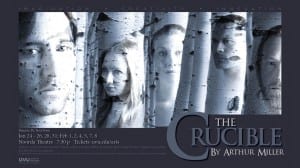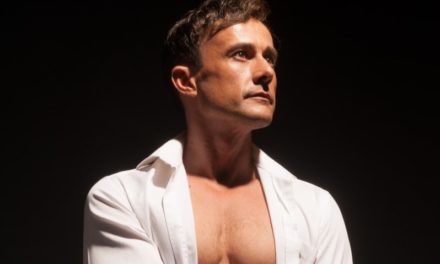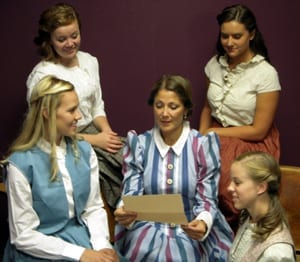OREM — The Crucible, as penned by Arthur Miller in 1953, is given apt resonance in UVU’s most recent production of this American work. Directed by D. Terry Petrie, I found myself drawn-in and compelled by the production, the various technical aspects working in harmony with the acting and script to provide a chilling and thought provoking evening of theater.

Show closes February 8, 2013.
Predicated on the events of the Salem witch trials some 300 years previous, The Crucible tells the story of a community gripped by fear and uncertainty. When Abigail Williams is rejected by her former lover John Proctor, the same man that seemingly stripped her childish innocence from her, hurt turns to vengeance as she accuses his wife, Elizabeth Proctor, of practicing witchcraft. The community already is in upheaval, and mob mentality forms at an alarming rate as accusations of witchcraft are flung left and right, all in the name of religious fervor. Brought through a fire of trials and persecutions, each member of the community is made to question themselves as the threat of accusation looms ever closer.
Laud is to be given to the cast of this show, who brought a wonderful sense of community to the stage. With frantic moments that often required everyone on stage, I found myself intrigued by the depth of relationships. These relationships were often explored in little side-moments on stage. In general, actors were easily heard and the heightened language of the lines was easily understood, though diction could be given greater emphasis. Patrick Kintz controlled the stage easily, his presence demanding focus, and I found his portrayal of John Proctor visceral and gripping. The arc of his character was clear, and I couldn’t help but to be moved by the emotional nuances of his character. His tenser, physical dynamic with Abigail (Bethany Woodruff) made for a gripping compulsion. And though Woodruff brought a real sensuality and power to her role, I would have loved to see more moments of Abigail’s vulnerability. Nevertheless, I was entranced by the character of Abigail and thought Woodruff more than brought justice to this renowned role. Equally as gripping was Brooke Hess Grant’s unusual portrayal of Elizabeth Proctor as a stronger, more confident helpmeet to John Proctor. The dynamics presented in her character were quite compelling, and I loved the chemistry she shared on stage with her husband. Further mention should be given to Erika Ovuoba for her portrayal of Tituba, bringing both a strong energy and presence to the stage, as well as Michael Coppieters for a daunting, intimidating presence as Deputy Governor Danforth.
I found the technical elements of this piece to be uplifting to the overall story, and did not detract from the viewing experience. Lighting design (Michael Gray) created a sense of the foreboding. The colors warmed and cooled with the story, and almost uncomfortably stark at times in more tense scenes. Sound (Kevin Criman) helped to create the aura of a grove of trees, though those moments underscored by music were definitely given more shape and urgency than others. Costuming (Heather Michelle Ole) and makeup (Ann Thomas) were subtle enough not to pull away focus, and helped to uplift the characters and show change as the story progressed. The use of the scrim was, I thought, well done, which turned the theater space into a grove of trees. On the other hand, I found the placement of the action within the grove of trees an interesting choice by the director, and one that I grew to appreciate as the symbolism of the choice manifested itself. The scene transitions were fluid, and I liked the juxtaposition of the reverence of the grove with the irreverence of all the accusations flying about and all the lies being cast. But for the most part, the intimacy of the space was preserved.
However, there were moments when the blocking felt clumpy, or moments when it was particularly hard to see. It was frustrating to have to peer around actors to try to discern the action on stage. The first half of the play read a little unclear at parts and dragged every now and then, and some of the pacing feeling a little uneven. But by the second half the action was tighter and the story very clear. I was entirely impressed with John Proctor’s “Leave me my name” speech because it had the climatic emotions and necessary sense of urgency. I found it an emotionally compelling play, some clever little bit of blocking and lighting right at the end giving me chills.
My greatest reservation in Petrie’s production of this classic play comes from the introduction of a narrative-type character—the Spirit Guide (Monica Santos). For someone unfamiliar with the script, this character may help to delineate the story more and give clarity. I, however, was confused by what the role meant exactly. Some of the blocking and insertion into the scene made me to believe she was wholly responsible for the witchcraft, and I was not entirely sure what her role in the events, as she was the sole Native American character. It was certainly a bold move on the part of the director, though I find it didn’t necessarily resonate for me.
All the same, I quite liked this production of The Crucible. The show has long since been a personal favorite of mine, and seeing UVU’s production only reaffirmed my enthusiasm for the piece. Though written during an era of McCarthyism, the themes and issues presented easily resonate with a modern day audience and leave many interesting questions in my mind. In a time of many questions and doubts, The Crucible seemed an appropriate choice that reflected the potential hysteria of a modern day social and political climate. UVU’s production shows that the pertinence of Arthur Miller’s piece remains. I would recommend it to anyone seeking a thought-provoking, poignant evening of theater.





